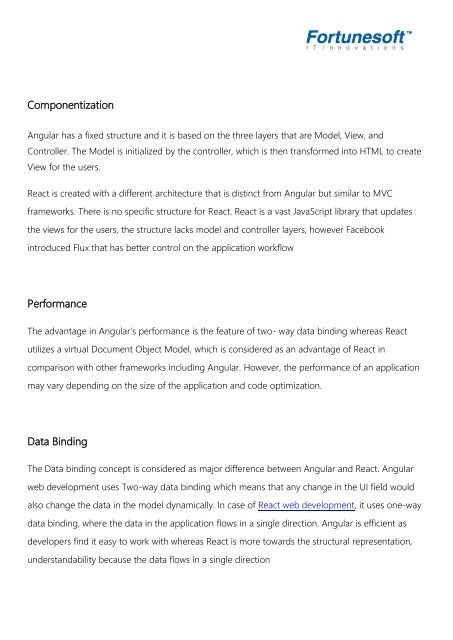Angular Vs React - Comparision between the Two
With so many JavaScript frameworks available for server-side and client-side Angular and React are popular among them. Here are the key differences between the two to help you choose them effectively for your next project.
With so many JavaScript frameworks available for server-side and client-side
Angular and React are popular among them. Here are the key differences between the two to help you choose them effectively for your next project.
You also want an ePaper? Increase the reach of your titles
YUMPU automatically turns print PDFs into web optimized ePapers that Google loves.
Componentization<br />
<strong>Angular</strong> has a fixed structure and it is based on <strong>the</strong> three layers that are Model, View, and<br />
Controller. The Model is initialized by <strong>the</strong> controller, which is <strong>the</strong>n transformed into HTML to create<br />
View for <strong>the</strong> users.<br />
<strong>React</strong> is created with a different architecture that is distinct from <strong>Angular</strong> but similar to MVC<br />
frameworks. There is no specific structure for <strong>React</strong>. <strong>React</strong> is a vast JavaScript library that updates<br />
<strong>the</strong> views for <strong>the</strong> users, <strong>the</strong> structure lacks model and controller layers, however Facebook<br />
introduced Flux that has better control on <strong>the</strong> application workflow<br />
Performance<br />
The advantage in <strong>Angular</strong>’s performance is <strong>the</strong> feature of two- way data binding whereas <strong>React</strong><br />
utilizes a virtual Document Object Model, which is considered as an advantage of <strong>React</strong> in<br />
comparison with o<strong>the</strong>r frameworks including <strong>Angular</strong>. However, <strong>the</strong> performance of an application<br />
may vary depending on <strong>the</strong> size of <strong>the</strong> application and code optimization.<br />
Data Binding<br />
The Data binding concept is considered as major difference <strong>between</strong> <strong>Angular</strong> and <strong>React</strong>. <strong>Angular</strong><br />
web development uses <strong>Two</strong>-way data binding which means that any change in <strong>the</strong> UI field would<br />
also change <strong>the</strong> data in <strong>the</strong> model dynamically. In case of <strong>React</strong> web development, it uses one-way<br />
data binding, where <strong>the</strong> data in <strong>the</strong> application flows in a single direction. <strong>Angular</strong> is efficient as<br />
developers find it easy to work with whereas <strong>React</strong> is more towards <strong>the</strong> structural representation,<br />
understandability because <strong>the</strong> data flows in a single direction





